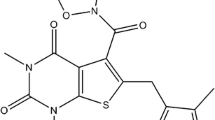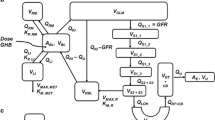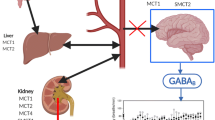ABSTRACT
Purpose
L-lactate represents a potential treatment for GHB overdose by inhibiting GHB renal reabsorption mediated by monocarboxylate transporters. Our objective was to assess the dose-dependence of L-lactate treatment, with and without D-mannitol, on GHB toxicokinetics/toxicodynamics (TK/TD).
Methods
Rats were administered GHB 600 mg/kg i.v. with L-lactate (low and high doses), D-mannitol, or L-lactate (low dose) with D-mannitol. GHB-induced sleep time and GHB plasma, urine and brain extracellular fluid (ECF) concentrations (by LC/MS/MS) were determined. The effect of L-lactate and D-mannitol on the uptake and efflux of GHB was assessed in rat brain endothelial RBE4 cells.
Results
L-lactate treatment increased GHB renal clearance from 1.4 ± 0.1 ml/min/kg (control) to 2.4 ± 0.2 and 4.7 ± 0.5 ml/min/kg after low and high doses, respectively, and reduced brain ECF AUC values to 65 and 25% of control. Sleep time was decreased from 137 ± 12 min (control) to 91 ± 16 and 55 ± 5 min (low and high L-lactate, respectively). D-mannitol did not alter GHB TK/TD and did not alter L-lactate’s effects on GHB TK/TD. L-lactate, but not D-mannitol, inhibited GHB uptake, and increased GHB efflux from RBE4 cells.
Conclusions
L-lactate decreases plasma and brain ECF concentrations of GHB, decreasing sedative/hypnotic effects.




Similar content being viewed by others
Abbreviations
- aCSF:
-
artificial cerebrospinal fluid
- AUC:
-
area under the plasma concentration-time curve
- BBB:
-
blood–brain barrier
- CHC:
-
α-cyano-4-hydroxycinnamate
- Clr :
-
renal clearance
- ECF:
-
extracellular fluid
- GABA:
-
gamma-aminobutyric acid
- GHB:
-
γ-hydroxybutyrate
- MCT:
-
monocarboxylate transporter
- TK/TD:
-
toxicokinetics/toxicodynamics
REFERENCES
Andriamampandry C, Taleb O, Kemmel V, Humbert JP, Aunis D, Maitre M. Cloning and functional characterization of a gamma-hydroxybutyrate receptor identified in the human brain. FASEB J. 2007;21(3):885–95. Epub 2007/01/02.
Andriamampandry C, Taleb O, Viry S, Muller C, Humbert JP, Gobaille S, et al. Cloning and characterization of a rat brain receptor that binds the endogenous neuromodulator gamma-hydroxybutyrate (GHB). FASEB J. 2003;17(12):1691–3.
Gallimberti L, Spella MR, Soncini CA, Gessa GL. Gamma-hydroxybutyric acid in the treatment of alcohol and heroin dependence. Alcohol. 2000;20(3):257–62.
Dyer JE. Gamma-hydroxybutyrate: a health-food product producing coma and seizurelike activity. Am J Emerg Med. 1991;9(4):321–4.
Halkitis PN, Palamar JJ, Mukherjee PP. Poly-club-drug use among gay and bisexual men: a longitudinal analysis. Drug Alcohol Depend. 2007;89(2–3):153–60. Epub 2007/02/03.
Varela M, Nogue S, Oros M, Miro O. Gamma hydroxybutyrate use for sexual assault. Emerg Med J. 2004;21(2):255–6.
Okun MS, Boothby LA, Bartfield RB, Doering PL. GHB: an important pharmacologic and clinical update. J Pharm Pharm Sci. 2001;4(2):167–75.
Wood DM, Nicolaou M, Dargan PI. Epidemiology of recreational drug toxicity in a nightclub environment. Subst Use Misuse. 2009;44(11):1495–502. Epub 2009/11/27.
Mason PE, Kerns 2nd WP. Gamma hydroxybutyric acid (GHB) intoxication. Acad Emerg Med. 2002;9(7):730–9.
Wang Q, Lu Y, Yuan M, Darling IM, Repasky EA, Morris ME. Characterization of monocarboxylate transport in human kidney HK-2 cells. Mol Pharm. 2006;3(6):675–85. Epub 2006/12/05.
Wang Q, Morris ME. The role of monocarboxylate transporter 2 and 4 in the transport of gamma-hydroxybutyric acid in mammalian cells. Drug Metab Dispos Biol Fate Chem. 2007;35(8):1393–9. Epub 2007/05/16.
Fishbein WN, Merezhinskaya N, Foellmer JW. Relative distribution of three major lactate transporters in frozen human tissues and their localization in unfixed skeletal muscle. Muscle Nerve. 2002;26(1):101–12.
Leino RL, Gerhart DZ, Drewes LR. Monocarboxylate transporter (MCT1) abundance in brains of suckling and adult rats: a quantitative electron microscopic immunogold study. Brain Res Dev Brain Res. 1999;113(1–2):47–54.
Halestrap AP, Price NT. The proton-linked monocarboxylate transporter (MCT) family: structure, function and regulation. Biochem J. 1999;343(Pt 2):281–99.
Wang Q, Wang X, Morris ME. Effects of L-lactate and D-mannitol on gamma-hydroxybutyrate toxicokinetics and toxicodynamics in rats. Drug Metab Dispos Biol Fate Chem. 2008;36(11):2244–51. Epub 2008/08/23.
Carter LP, Koek W, France CP. Behavioral analyses of GHB: receptor mechanisms. Pharmacol Ther. 2009;121(1):100–14. Epub 2008/11/18.
Morse BL, Vijay N, Morris ME. Gamma-hydroxybutyrate (GHB)-induced respiratory depression: combined receptor-transporter inhibition therapy for treatment in GHB overdose. Mol Pharmacol. 2012;82(2):226–35. Epub 2012/05/09.
Roiko SA, Felmlee MA, Morris ME. Brain uptake of the drug of abuse gamma-hydroxybutyric acid in rats. Drug Metab Dispos Biol Fate Chem. 2012;40(1):212–8. Epub 2011/10/25.
Felmlee MA, Roiko SA, Morse BL, Morris ME. Concentration-effect relationships for the drug of abuse gamma-hydroxybutyric acid. J Pharmacol Exp Ther. 2010;333(3):764–71. Epub 2010/03/11.
Morris ME, Hu K, Wang Q. Renal clearance of gamma-hydroxybutyric acid in rats: increasing renal elimination as a detoxification strategy. J Pharmacol Exp Ther. 2005;313(3):1194–202.
Rapoport SI. Osmotic opening of the blood–brain barrier: principles, mechanism, and therapeutic applications. Cell Mol Neurobiol. 2000;20(2):217–30. Epub 2000/03/04.
Paxinos G, Watson C. The rat brain in stereotaxic coordinates. New York: Academic; 1986.
de Lange EC, de Boer AG, Breimer DD. Methodological issues in microdialysis sampling for pharmacokinetic studies. Adv Drug Deliv Rev. 2000;45(2–3):125–48. Epub 2000/12/08.
Bouw MR, Hammarlund-Udenaes M. Methodological aspects of the use of a calibrator in in vivo microdialysis-further development of the retrodialysis method. Pharm Res. 1998;15(11):1673–9. Epub 1998/12/02.
Felmlee MA, Wang Q, Cui D, Roiko SA, Morris ME. Mechanistic toxicokinetic model for gamma-hydroxybutyric acid: inhibition of active renal reabsorption as a potential therapeutic strategy. AAPS J. 2010;12(3):407–16. Epub 2010/05/13.
Ronaldson PT, Lee G, Dallas S, Bendayan R. Involvement of P-glycoprotein in the transport of saquinavir and indinavir in rat brain microvessel endothelial and microglia cell lines. Pharm Res. 2004;21(5):811–8. Epub 2004/06/08.
Smith JP, Drewes LR. Modulation of monocarboxylic acid transporter-1 kinetic function by the cAMP signaling pathway in rat brain endothelial cells. J Biol Chem. 2006;281(4):2053–60. Epub 2005/11/23.
Bhattacharya I, Boje KM. GHB (gamma-hydroxybutyrate) carrier-mediated transport across the blood–brain barrier. J Pharmacol Exp Ther. 2004;311(1):92–8.
Morse BL, Felmlee MA, Morris ME. Gamma-hydroxybutyrate blood/plasma partitioning: effect of physiologic pH on transport by monocarboxylate transporters. Drug Metab Dispos Biol Fate Chem. 2012;40(1):64–9. Epub 2011/10/07.
Wang Q, Darling IM, Morris ME. Transport of gamma-hydroxybutyrate in rat kidney membrane vesicles: role of monocarboxylate transporters. J Pharmacol Exp Ther. 2006;318(2):751–61. Epub 2006/05/19.
Roux F, Couraud PO. Rat brain endothelial cell lines for the study of blood–brain barrier permeability and transport functions. Cell Mol Neurobiol. 2005;25(1):41–58. Epub 2005/06/21.
Morris ME, Felmlee MA. Overview of the proton-coupled MCT (SLC16A) family of transporters: characterization, function and role in the transport of the drug of abuse gamma-hydroxybutyric acid. AAPS J. 2008;10(2):311–21. Epub 2008/06/05.
Stanley WC, Wisneski JA, Gertz EW, Neese RA, Brooks GA. Glucose and lactate interrelations during moderate-intensity exercise in humans. Metabolism. 1988;37(9):850–8. Epub 1988/09/01.
Tappy L, Cayeux MC, Chiolero R. Effects of sodium lactate on ventilation and acid–base balance in healthy humans. Clin Physiol. 1996;16(4):393–401. Epub 1996/07/01.
Morris ME, Morse BL, Baciewicz GJ, Tessena MM, Acquisto NM, Hutchinson DJ, et al. Monocarboxylate transporter inhibition with osmotic diuresis increases gamma-hydroxybutyrate renal elimination in humans: a proof-of-concept study. J Clin Toxicol. 2011;1:105. doi:10.4172/2161-0494.1000105.
ACKNOWLEDGMENTS AND DISCLOSURES
This work was supported by the National Institutes of Health National Institute on Drug Abuse [grant DA023223]. NV was funded by a fellowship from Pfizer Global Inc.
Author information
Authors and Affiliations
Corresponding author
Rights and permissions
About this article
Cite this article
Roiko, S.A., Vijay, N., Felmlee, M.A. et al. Brain Extracellular γ-hydroxybutyrate Concentrations are Decreased by L-lactate in Rats: Role in the Treatment of Overdoses. Pharm Res 30, 1338–1348 (2013). https://doi.org/10.1007/s11095-013-0973-z
Received:
Accepted:
Published:
Issue Date:
DOI: https://doi.org/10.1007/s11095-013-0973-z




